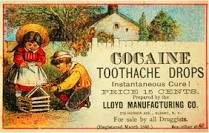







History Of Drugs
-
I wonder what's around the bend said the explorer
I wonder what that plant is? said the collector
I wonder what's in it? said the chemist
I wonder what activity it has? said the pharmacologist
I wonder if it'll work in this case? said the physician
I hope she lives! said the father Please God ! said the mother
I think she'll be all right in the morning, said the nurse
Margret Kregis/ Green Medicine
Ever since Human Beings first walked on the Earth they have searched for materials that would ease their suffering, as time went on they came to know which plants would feed their hunger, which would poison, and which would heal. In the ancient Sumerian town of Nippur, prescriptions were written out on clay tablets and from these we know that over 4,000 years ago people used flowers, seeds, leaves, fruits, roots and barks in their medicines.
Among the plants they used were thyme, myrrh and pine - which are still used today in the form of essential oils and willow - the source of aspirin. Aspirin is another name for acetylsalicylic acid, a synthetic first produced in 1899 and derived from salicin, the active ingredient, named after salix - a family of Willow tree.
For thousands of years resins and juices from the bark and leaves of the Willow have been used to treat rheumatism, neuralgia and other ailments, but the scientific history of the Willow is traced to an eighteenth-century clergyman, Edmund Stone who had by recommendation or accident acquired the habit of chewing the bark.
Interestingly, salicin is also a drug for the tree itself - conferring 'systematic acquired resistance' on it, according to scientist at the agricultural Biotechnology Research Unit of Ciba-Geigy Ltd, the multinational chemical company.
Apparently, the Willow trees use it to ward off infections, which they are prone to because they often grow by stagnant water.
Malaria has killed more people in this world than any other disease. The first drug treatment was quinine, which continues to be used against strains of the disease which are resistant to newer antimalarials, and is more commonly prescribed to prevent painful leg cramps at night. The source of this drug is the bark of the flowering evergreen, Cinchona, which grows on the Andean slopes of South America.
The bark was first imported to Europe in 1645 and widely used as an antimalarial although its mysteries were not uncovered until 1819 when pharmaceutical chemists extracted one of the alkaloids and named it quinine after the Peruvian Indian word Quina-quina, 'the bark of barks'.
As they explored their natural environment, people inevitably came across plants which have an effect on the mind. So it was in India and Africa where for hundreds and perhaps thousands of years people used the root related species of rauwolfia as a tranquillizer and treatment for 'moon madness' - lunacy. In 1925 an eminent Nigerian living in London became psychotic but the doctors treating him couldn't help. The witch doctor was summoned and arrived with his rauwolfia root - which did the trick.
The active substances in rauwolfia (named after Leonhard Rauwolf, the sixteenth-century physician and plant explorer) were isolated in the late 1940s by Indian scientists and after more work by the Swiss drug company, Ciba-Geigy Ltd, the first mind or mood altering drug based on rauwolfia alkaloids, reserpine, hit the market. And what a market it was - $80 million by the mid 1970s.
Reference: Fragrant Mind/ V Worwood
Read More....History of Drugs - 2
